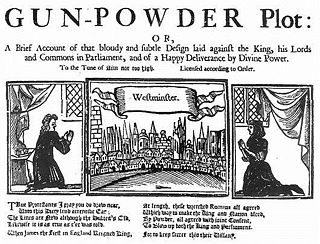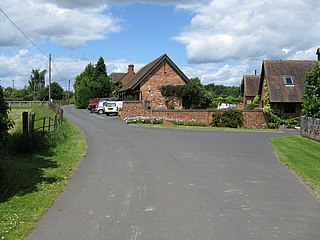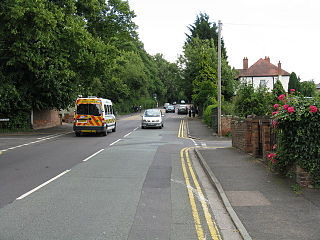
The Gunpowder Plot of 1605, in earlier centuries often called the Gunpowder Treason Plot or the Jesuit Treason, was an unsuccessful attempted regicide against King James I by a group of English Catholics led by Robert Catesby who considered their actions attempted tyrannicide and who sought regime change in England after decades of religious persecution.

Henry Garnet, sometimes Henry Garnett, was an English Jesuit priest executed for high treason, based solely on having had advanced knowledge of the 1605 Gunpowder Plot and having refused to violate the Seal of the Confessional by notifying the authorities. Born in Heanor, Derbyshire, he was educated in Nottingham and later at Winchester College before he moved to London in 1571 to work for a publisher. There he professed an interest in legal studies and in 1575, he travelled to the continent and joined the Society of Jesus. He was ordained in Rome some time around 1582.
A priest hole is a hiding place for a priest built in England or Wales during the period when Catholics were persecuted by law. Following the accession of Queen Elizabeth I to the throne in 1558, there were several Catholic plots designed to remove her, and severe measures, including torture and execution, were taken against Catholic priests. From the mid-1570s, hides were built into houses to conceal priests from priest hunters. Most of the hides that survive today are in country manor houses, but there is much documentary evidence, for example in the Autobiography and Narrative of the Gunpowder Plot of John Gerard, of hides in towns and cities, especially in London.

Sir Thomas Habington or Abington (1560–1647) was a Catholic English antiquary. He is particularly remembered as an early county historian of Worcestershire, although little of his work was published in his lifetime.

Thomas Garnet was a Jesuit priest who was executed in London. He is the protomartyr of Saint Omer and of Stonyhurst College. He was executed at Tyburn and is one of the Forty Martyrs of England and Wales.
Mark Barkworth was a Catholic priest, oblate of the Order of St Benedict, and martyr.

Nicholas Owen, S.J., was an English Jesuit lay brother who was the principal builder of priest holes during the reigns of Queen Elizabeth I and James I of England. Owen built many priest holes in the buildings of English Catholics from 1588 until his final arrest in 1606, when he was tortured to death by prison authorities in the Tower of London. Owen is honoured as a martyr by the Catholic Church and was canonized by Pope Paul VI in 1970.

Holt is a village and civil parish in the Malvern Hills District of the county of Worcestershire, England. The church is dedicated to St. Martin, and dates from about the 12th century. Holt Bridge, over the River Severn, was designed by Thomas Telford, and opened in 1830.
Henry Foley, S.J. was an English Jesuit Roman Catholic church historian.
John Woodcock (1603–1646) was a Franciscan priest from Lancashire executed in August 1646 under the Jesuits, etc. Act 1584 for being a priest and present in the realm.
Oswald Tesimond, SJ was an English Jesuit born in either Northumberland or York who, while not a direct conspirator, had some knowledge of the Gunpowder Plot beforehand.

Edward Oldcorne alias Hall was an English Jesuit priest. He was known to people who knew of the Gunpowder Plot to destroy the Parliament of England and kill King James I; and although his involvement is unclear, he was caught up in the subsequent investigation. He is a Roman Catholic martyr and was beatified in 1929.
Richard Sergeant (executed at Tyburn, 20 April 1586) was an English Roman Catholic priest. He is a Catholic martyr, beatified in 1987.

Hindlip Hall is a stately home in Hindlip, Worcestershire, England. The first major hall was built before 1575, and it played a significant role in both the Babington and the Gunpowder plots, where it hid four people in priest holes. It was Humphrey Littleton who told the authorities that Edward Oldcorne was hiding here after he had been heard saying Mass at Hindlip Hall. Four people were executed and the owner at that time barely escaped execution himself due to the intercession of Lord Monteagle.
Humphrey Littleton, or Humphrey Lyttelton, was a member of the Lyttelton family, who was executed for his involvement in the Gunpowder plot. Robert Wintour and Stephen Littleton who had escaped from the fight at Holbeche House were captured at Hagley Park on 9 January 1606 despite Littleton's protests that he was not harbouring anyone. It was Littleton who told the authorities that Edward Oldcorne was hiding at Hindlip Hall after he had given him mass. Wintour, Oldcorne, and both Littletons were all executed.

Red Hill is an area of Worcester, Worcestershire, England. It is in the south-east of the city on the A44. It has historically been used as high ground to attack the city and as a place of execution.
Edward Thwing was an English Catholic priest and martyr.
John Habington or Abington (1515-1581) was an English courtier and administrator.
Mary Habington or Abington, néeParker was an English recusant. Antiquarian writers thought that she was the author of the anonymous letter to her brother William Parker, 4th Baron Monteagle which warned of the Gunpowder Plot. This theory is dismissed by modern historians. She sheltered a number of Catholic priests and recusants at her Worcestershire home Hindlip Hall.









